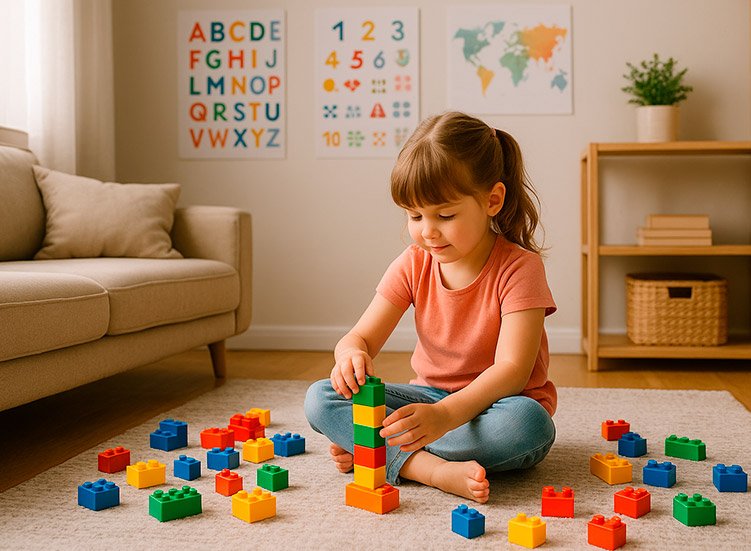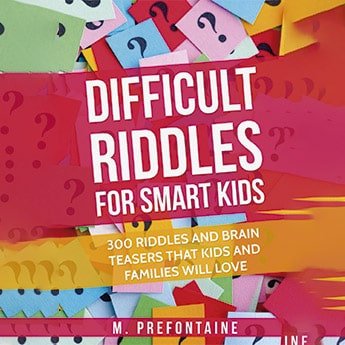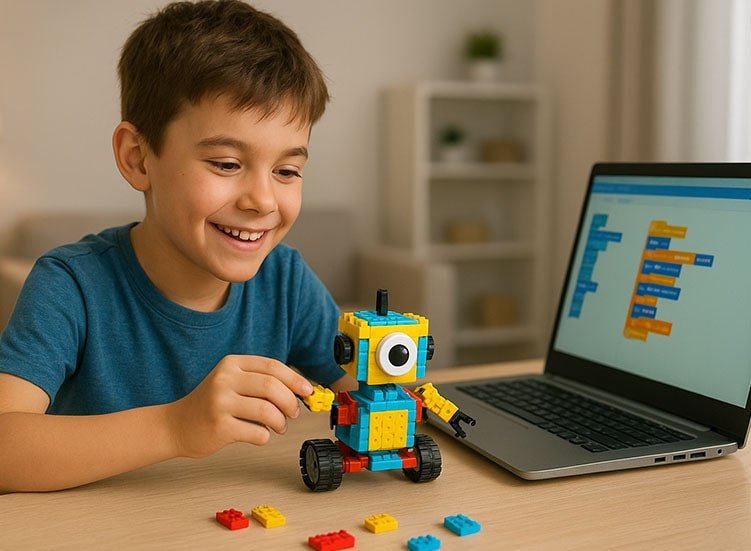Play is more than just fun: it is one of the most effective ways of learning in childhood. Educational games for children, when chosen appropriately for the child’s age, contribute significantly to cognitive, motor, emotional and social development.
In this article, you will find a practical and detailed selection of educational games organized by age group, from babies to 10 years old, with suggestions adapted to child development at each stage.
Why are educational games for children important?
Educational games are designed to combine entertainment and learning. They provide sensory and cognitive stimuli that help children to:
✅ 1. Development of logical reasoning
Educational games that involve sequences, patterns, classifications or solving challenges (such as dominoes, puzzles or mazes) help children to organize their thoughts and find solutions.
How does this help?
Logical reasoning is essential for mathematics, reading and solving everyday problems. Children who exercise this type of thinking are able to anticipate consequences, make connections between ideas and adapt better to new situations.
Practical example:
Games that involve linking objects to categories (e.g. “link the animal to its habitat”) encourage comparisons, inferences and critical analysis, the foundations of logical thinking.
🎯 2. Improved motor coordination
Games that require fitting, painting, cutting, stacking, assembling or manipulating pieces develop fine motor coordination (hands/fingers) and gross motor coordination (large movements).
Why does this matter?
These skills are essential for tasks such as writing, getting dressed, brushing teeth, cutting with scissors and using school tools in everyday life.
Practical example:
Building LEGO blocks requires visual attention, spatial planning and precise hand movements, all of which help prepare children for writing.
💬 3. Stimulating language and communication
Games that involve telling stories, naming objects, singing, imitating sounds or role-playing (such as theater or board games with questions) are great for expanding vocabulary and verbal fluency.
Direct benefits:
- Improves oral expression.
- Stimulates active listening.
- Develops the ability to tell stories with a beginning, middle and end.
- Reinforces reading and writing skills.
Practical example:
A card game with pictures and questions like “Who is this character?” or “What is he doing?” encourages children to create complete sentences, describe and interpret.
🧩 4. Encouragement of problem-solving
Games with progressive challenges, trial and error, and decision-making help children to think critically, test hypotheses and find alternative paths.
Importance in practice:
Children who play with this type of challenge learn that making mistakes is part of the process and develop resilience, autonomy and strategic thinking.
Practical example:
Games like “get out of the maze”, “solve the puzzle” or assemble something in less time than your colleague, teach you to analyze, plan and execute actions logically.
💛 5. Promotion of socio-emotional skills
Collaborative games, which involve turns, listening, cooperation, empathy and problem-solving conflicts, work on the child’s emotional side in a structured way.
Why is this valuable?
The child learns to:
- Wait their turn.
- Deal with frustration (losing, making mistakes).
- Celebrate their own achievements and those of their peers.
- Cooperate and negotiate.
Practical example:
Games like “Group Jenga”, “Memory Game in Pairs” or “Who Am I?” encourage coexistence, respect and teamwork, which are essential for life in society and academic success.
📚 6. Reinforcement of school content in a fun way
One of the greatest advantages of educational games is that they teach without the child realizing that they are studying. This increases engagement and reduces resistance to schoolwork.
How does it work?
Games with themes of literacy, mathematics, science or geography make learning lighter, more active and contextualized. In addition, they help to fix content in a natural way.
Practical example:
A “Word Battle” game with syllables helps with phonological awareness and word construction, a basic literacy skill, without seeming like a formal lesson.
Playing is a natural language of childhood. When chosen well, educational games are direct bridges between playing and learning, preparing children not only for school, but for life.
Whether in the classroom, at home or in therapeutic environments, games that stimulate multiple areas at the same time are powerful allies in the overall development of the child.
In addition, they are a powerful way to reinforce school content in a fun and less formal way.
👶 Educational games for children (babies from 0 to 1 year old)
Objectives main:
- Stimulate the senses (sight, touch, hearing).
- Develop the first coordinated movements.
- Initiate interactions with objects and people.
Suggested games and toys:
1. Activity mats with textures and mirrors
These mats offer tactile and visual stimuli. Elements such as mirrors, mobiles and sounds promote safe exploration.
Where to buy: Amazon – Fisher-Price Activity Mat
2. Cloth or bath books
Encourage the habit of reading from an early age with resistant, washable books that can go in the bath.
Where to buy: Amazon – Children’s Bath Book Kit
3. Fabric cubes with sounds
Cubes with rattles, different textures and figures help with perception and motor control.
4. Sensory musical mats
They react to touch with sounds and lights, stimulating coordination and the notion of cause and effect.
5. Mobiles with movement and light
They develop visual focus and depth perception. Ideal for cribs or strollers.
6. Stacking toys (soft version)
Like silicone cups or large rings that can be bitten. They stimulate coordination and initial motor skills.
🚼 Educational games for children aged 1 to 2
Main objectives:
- Explore cause and effect.
- Initiate more refined motor actions.
- Introduce concepts of shape, color and size.
Game suggestions:
1. Toys that fit together with large pegs
Games of geometric shapes with colorful pieces that are safe to handle.
2. Stackable cubes
They work on notions of balance, order and sizes. They encourage trial and error in a playful way.
3. Musicalization with simple instruments
Such as drums, tambourines and xylophones. Music stimulates hearing, rhythm and language.
4. Fitting toys with animals and sounds
Introduces animal names, colors and sounds, facilitating auditory learning.
5. Cars or pull-along toys
Stimulates walking, balance and spatial awareness.
6. Sensory boxes with different objects
You can assemble them with colored rice, balls, fabrics and utensils to explore with your hands.
👧 Educational games for children aged 2 to 3
Main objectives:
- Improve fine motor coordination.
- Stimulate vocabulary and language.
- Start symbolic play.
Game suggestions:
1. Non-Toxic Play-Doh
Excellent for strengthening hands and fingers, as well as allowing for creative expression.
Where to buy: Amazon – Classic Play-Doh Kit
2. Large building blocks (like LEGO DUPLO)
They allow you to create different shapes and introduce concepts of construction and creativity.
3. Puzzles with 4 to 8 large pieces
They help with problem-solving and hand-eye coordination.
4. Shape and number fitting game
Like blocks that fit into molds with numbers and colors.
5. Interactive books with flaps and textures
They promote vocabulary and the association of images and words.
6. Games with miniatures (farm, animals, cars)
They encourage symbolic play and logical reasoning.
👧 Educational games for children aged 4 to 5
Main objectives:
- Improve fine motor skills.
- Explore games with simple rules.
- Stimulate memory and narrative language.
Game suggestions:
1. Memory games with illustrated cards
Ideal for exercising the brain and attention, in addition to expanding vocabulary.
2. Pretend play (kitchen sets, doctor, tools)
Promotes empathy, language, and social roles.
3. Painting with gouache paint, chalk or thick colored pencil
They work on creativity, grasping and color differentiation.
Where to buy: Amazon – Acrilex Children’s Painting Kit
4. Dominoes illustrated with letters or animals
Stimulates association and simple game rules.
5. Interactive mats with numbers and letters
Jumping in sequence helps to assimilate basic content.
6. Stories to assemble (books with scenes to order)
Develop narrative logic and creativity.
👦 Educational games for children aged 6 to 7
Main objectives:
- Encourage logical thinking.
- Introduce literacy and mathematical reasoning.
- Stimulate socialization and conflict resolution.
Game suggestions:
1. Letter or syllable dominoes
Helps to recognize sounds, words and language structure.
2. Simple board games (such as Ludo, Bingo or Tic Tac Toe)
Introduce logic, turns, counting and respect for rules.
3. Educational apps with reading and math games
There are several apps like “Lingokids”, “Khan Academy Kids” and “PlayKids” with educational activities.
4. Illustrated word searches
They present vocabulary in a fun way and promote concentration.
5. Cooperative board games (without winners)
Like “Snail’s Pace Race” or “Outfoxed!” that teach cooperation and teamwork.
6. Advanced building blocks (like LEGO City or LEGO Friends)
Develop construction, interpretation of instructions and creativity.
Where to buy: LEGO Friends Tree House
👧👦 Educational games for children aged 8 to 10
Main objectives:
- Improve strategic thinking.
- Develop social skills and healthy competition.
- Work on school content in a fun way.
Game suggestions:
1. Chess or checkers
They encourage concentration, anticipation and strategy.
2. Monopoly (junior versions)
Teaches basic notions of money, shopping, planning and negotiation.
Where to buy: Amazon – Monopoly
3. Science Kits and Experiments
Activities with mixtures, plants or simple reactions spark interest in science.
Where to buy: Amazon – Science Kit for Kids
4. Question and answer games (children’s trivia)
Ex: “Jogo do Saber Kids” and “Perguntados Jr.”, promote general knowledge.
5. Logic and programming kits (without screen)
Games like “Code & Go” or “Robo Mouse” teach basic coding concepts.
6. Gamebooks (with puzzle and decision challenges)
“Choose your own adventure” type, encourage reading and strategic thinking.
7. Educational card games (such as Uno Learn Colors, Fraction Cards)
Combine simple rules with reinforcement of school concepts.
Where to buy: Amazon – UNO Colors and Shapes Mattel
Tips for Choosing the Right Educational Games for Kids:
- Respect the recommended age: in addition to safety, it ensures that the game will be understood and used.
- Observe the child’s interests: some prefer movement, others logic or creation.
- Opt for games that evolve: modular toys or those with progressive challenges have a longer useful life.
- Interact together: when the adult participates, learning is deeper and more enjoyable.
FAQ – Perguntas frequentes sobre jogos educativos para crianças
From the first months. Sensory mats, cloth books and stimulus toys are already educational.
It depends. Games with a pedagogical function and controlled time can be allies in education.
Stores such as Amazon, Shopee, Mercado Livre and affiliate platforms such as Magalu have good options.
Both have value. The ideal is to balance tactile experiences with digital interactivity, according to the child’s age.
Yes. They reinforce cognitive skills such as memory, attention and logical reasoning, in addition to facilitating the assimilation of content such as letters, numbers and mathematical operations in a fun and contextualized way.
Common toys can be entertaining, but educational games are developed with clear pedagogical objectives, such as stimulating reading, developing spatial awareness, mathematical logic or socio-emotional skills, such as empathy and cooperation.
Consider the child’s development stage (motor, cognitive and emotional) and choose games with clear age indications. Games that are too easy are boring; games that are too difficult are frustrating. Always observe the child’s interest and reactions.
Yes! This is one of the biggest advantages. Playing at home makes learning more enjoyable, reinforces school content and strengthens family ties. It is a powerful way to practice without pressure.
Of course. Well-selected games can help children with dyslexia, ADHD, dyslalia, among other conditions. They offer visual and auditory stimuli, promote repetition without boredom and help with self-esteem.
It depends on the age and activity, but in general:
– Up to 3 years old: 15 to 30 minutes per game;
– From 4 to 6 years old: 30 to 45 minutes;
– From 7 to 10 years old: up to 1 hour, alternating types of games.
Important: play should be enjoyable, not an obligation.
Games that focus on:
– Phonological awareness (letter sounds);
– Word formation;
– Rhymes, syllables and image reading;
– Activities with movable letters, letter bingo, syllable dominoes, etc.
For young children, yes. Supervision ensures safety and pedagogical guidance. With older children, it is possible to encourage autonomy, but it is interesting to provide occasional mediation and talk about what was learned.
Yes! Several websites and blogs offer PDF materials with literacy, math, logic games, among others. Platforms such as Pinterest, Creative Teachers or even affiliate pages have great options.
Conclusion on educational games for children:
Remember that, more than learning, the most important thing is for children to have fun and feel motivated to explore the world around them. In fact, for children with high abilities or giftedness, playing also plays an essential role in emotional development. We suggest that parents of gifted children read this article to understand, why Gifted Children Need More Than Just Academic Content.
Playing educates and when the right game is offered at the right time, learning becomes natural, fun and much more efficient.
In this article, you saw how to choose educational games appropriate for age group, and understood the objectives of each stage of child development.
If you are a father, mother, educator or content creator, keep this guide as a reference and share it with those who also seek to educate with ease and creativity.
Did you like it? Share it with your mom and dad friends, so they can play and teach their children!
Click here for more content about Children & Education.
Click here for more content about Sports & Leisure.








